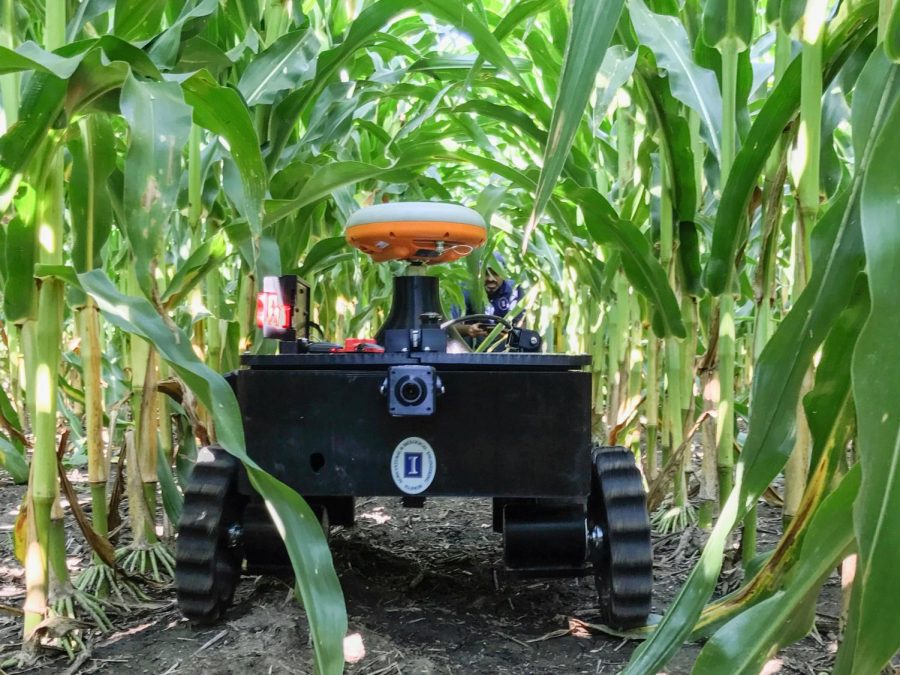University startup develops $5,000 agricultural robot
Photo Courtesy of Chinmay Soman
TerraSentia – the ultracompact, autonomous, teachable robot developed by EarthSense, Inc. was tested in a corn field in August, 2017. TerraSentia delivers critical plant information about plant traits to corp scientists and breeders, using a variety of sensors to obtain data and employing sophisticated on-board machine learning and machine vision algorithms to analyze the data.
January 23, 2018
Two University researchers have developed a $5,000 robot for agricultural purposes. The robot uses deep learning and computer vision software to process agricultural data for academic crop scientists and agricultural equipment companies.
“$5,000 is the target price right now,” Girish Chowdhary, University researcher, EarthSense co-founder and Chief Technology Officer. “Later on, we will have versions of this product that are more expensive, we will also have versions that will be cheaper. We’re expecting to have robots as low as $2,000 to $3,000.”
Chowdhary and Chinmay Soman, researcher at the University, started EarthSense, a startup company focused on agricultural robotics, in April 2016. They released their first product, TerraSentia, this year.
TerraSentia is a small robot that records information about crops under the leaves. This is useful for phenotyping and detecting variation for crop breeders and researchers.
“Our long term objective is to bring advanced machine learning to agriculture,” Soman said. “We are doing agricultural robotics in general, and phenotyping is just the first application we’re going after.”
Get The Daily Illini in your inbox!
Robotics traditionally used in agriculture are expensive and heavy, with little intelligence or ability to work without specific direction, Chowdhary said.
“We try to make smart software that makes dumb sensors do good things,” Chowdhary said.
TerraSentia uses cheaper, less advanced hardware with sophisticated software in order to make robots that are small and cheap but effective, he said.
“A lot of the magic is in the algorithms and the software and the machine learning, or other types of things. With this philosophy we were able to keep the prices very low.” Chowdhary said.
Chowdhary and Soman said they intend to develop the robot further with the help of their customers, targeting different features of TerraSentia to exactly what their customers are asking for.
“As we go forward, we don’t want to keep doing things at the University just because we think they’re the right things to do,” Soman said. “We want to involve our customers early on in the product development process to figure out exactly what they need.”
Soman and Chowdhary worked through their Early Adopter Program in which they allowed 20 companies to buy the robot, and they will work with them during this year to improve TerraSentia.
“We have a couple of major seed companies, one headquartered in the U.S., one in Europe, who are our early adopter customers,” Soman said. “In addition, we have some smaller crop genetics and agricultural equipment companies on board. We’re also partnering with several academic crop scientists at leading universities.”
The robot is built to be adapted for different specific purposes, including a mechanical weeding arm to automatically remove weeds while it surveys the crops.
Joseph Byrnes, junior in Engineering, joined EarthSense in fall 2017. The startup brought on undergraduate students to work on TerraSentia. Byrnes is helping design the prototype weeding arm.
“We’re giving the product to the user and saying ‘Here is the product, it isn’t ready, just tell me what you want and together we can make it ready,’” Chowdhary said.
Chowdhary said the idea was inspired by drones.
“When I came here, we were focused on getting drones to do useful things regarding agriculture,” Chowdhary said. “We started realizing that the drones really needed a teammate that could go under the canopy and access different kinds of data.”







